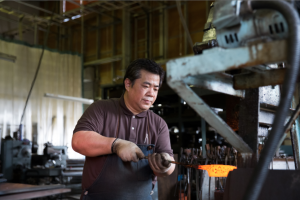History/Workshop maxims
Workshop maxims | Sanjo | Hocho-Kobo Tadafusa | Tsubame-Sanjo
Workshop maxims 工房心得
To hand down expertise and skills of blacksmiths in Sanjo and continue to exist.
三条の鍛冶の技を後世に伝承し、存続させ続ける事
To keep a production centre and create employment in Sanjo.
三条が庖丁の産地として存続し、規模を維持し続けることにより地元地域の雇用を生み出す事
To learn new things from the past and develop the factory.
温故知新の心。変化を恐れずに変えていくべき所は変え、残すべき所は残す事
To work on ‘Monodukuri’ craft with pride.
誇りを持ってものづくりに取り組む事
To make the work an admiration of next generation in Sanjo.
三条の子供たちの憧れとなるべき仕事にする事
Sanjo as a town of blacksmiths
Sanjo is well-known as “a town of blacksmiths” as well as a town of hardware production highly praised by the people inside and outside of Japan. The Ikarashi River is located in the center of Sanjo. Once upon a time, the river which is called “Abare-Gawa(brutal river)”, was well-known for having been flooded again and again since olden times. During three years from the second year of Kanei era(1625), Otani Seibei, who served as a governor’s officer of Edo-Bakufu(the government in Edo era), came to give aid to poor peasants in the area that were suffering from the constant flooding. He also invited blacksmiths to teach the locals how to make Japanese hand-forged nails for their side business.
In the first year of Kanbun era(1661), new forging techniques were introduced from Aizu area to Sanjo. Thanks to that, the blacksmiths in Sanjo began to diverge from producing nails to specialize in making sickles, saws, and kitchen knives.
With increase in number of the specialized blacksmiths, marchants gradually appeared to deal with hardware products made in Sanjo. They used rivers such as the Igarashi River and the Shinano River(the longest river in Japan) to expand their business area. As a result of that, they also contributed to make Sanjo well-known as “a town of hardware products” throughout the country.
Hocho-Kobo Tadafusa
During these forging histories in Sanjo, the founder, Sone Torasaburo started Tadafusa from nothing in the 23rd year of the Showa era(1948). He made various kinds of knives such as sickles, short swords and kitchen knives by using the forging techniques he learned as an apprentice making hand-forged metal scales. He gradually started to specialize in making fishing knives and then also address a need to create kitchen knives for home and professional use and special knives for Soba up to today. Since the company’s foundation, we strive to create “the best products” for our customers by hand through every single process and to make each knife with our utmost enthusiasm.
Our products have won various prizes, such as Good-Design Award and Good Design Award of Small and Medium Enterprise, because we have continued making great efforts to create hand-forged knives that customers really desire with the demands of the present day.
From now on, we promise to keep creating knives with great high-quality to meet customers requests and the needs of the current age. Like fighting against the disasters of the Ikarashi River, we will continue to promote “Sanjo as a town of blacksmiths” to the world through our products.
What is going on in Tsubame-Sanjo today
You might already know, but Tsubame City, which is next to Sanjo City, is also internationally known for its metalwork, traditional crafts, and cutlery. The industrial area of Sanjo and Tsubame is called “Tsubame-Sanjo,” and there are various “Monozukuri” from traditional handicrafts to the latest technology used in the airline industry. Many products are exported to other countries, and more people from different countries move to Tsubame-Sanjo to learn knowledge and techniques.
Recently, the factories in the area have opened their doors to the public. You cannot just see craftsmanship there, you can also experience it. This is the way to make a strong connection between the craftsmen and users.
The Tsubame-Sanjo Factory Festival, which started in 2013, is a big event for showcasing their factories and products to the public. About 100 factories in the area and neighboring cities took part in the festival and showed the processes that you cannot normally see. Tadafusa also welcomed a lot of people inside and outside Japan to our factory.
In 2020, the festival was held online, and the spectacular videos of craftsmanship were released. Tadafusa introduced various types of knives that we have manufactured in the video. The video was created based on the exhibition, BIOLOGY OF METAL: METAL CRAFTSMANSHIP IN TSUBAME-SANJO held at Japan House London in 2018. On the website of the festival, you can watch the videos of the craftsmen’s daily workings and learn the history of metalworking in Tsubame-Sanjo. Please take a look at the videos or their social media posts.
Video Tadafusa various types of knives (English sub)
Video Tadafusa factory tour (Japanese)


